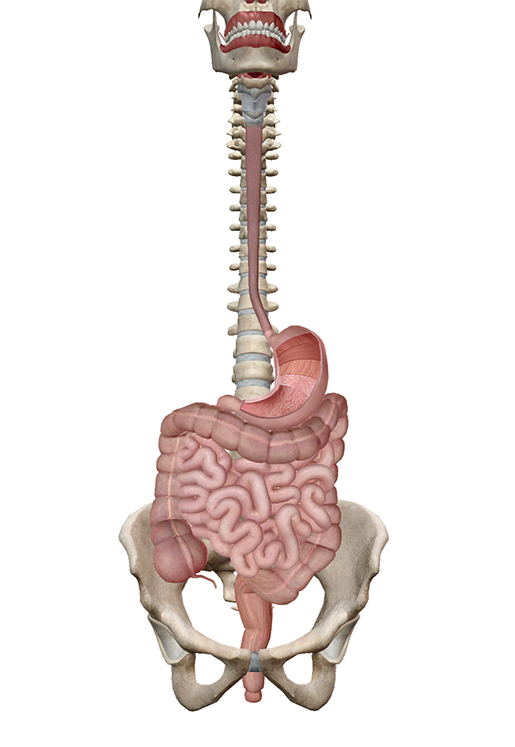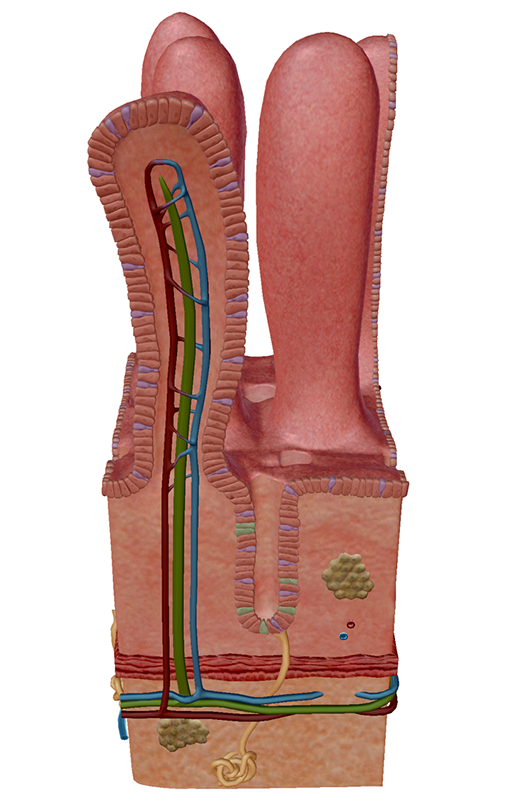Energy & Metabolism Part 1: Nutrients
Posted on 11/27/19 by Laura Snider
Do you ever feel like you need more energy? Maybe you stayed up all night studying for exams, or you just finished an intense workout at the gym, or it’s almost lunchtime and you’re losing focus (or getting hangry...or both).
While I can’t give you more energy via the internet (it would be pretty amazing if I could, though), I can tell you about the basics of energy and metabolism, and that’s exactly what this two-part blog post will focus on. What nutrients does the body need to survive, where do we get them, and how does the body break them down into materials it can use? What in the world is ATP and what do we use it for?
Hopefully, learning about how our bodies make energy will be just the pick-me-up you need!
Click here to learn more about the digestive system and nutrient absorption with Visible Body's Small Intestine/FAST Exam A&P eBook!
Nutrients: We Are What We Eat
Human life would be impossible without the nutrients we get from our food: water, proteins, lipids, vitamins, minerals, and carbohydrates. These basic molecules that make up the plant and animal matter we consume are the same ones our own cells need to repair themselves and to supply the energy they need to perform key functions.
You’re probably already aware that humans are about 64% water. It’s present in all of our cells, and it’s vital for the biochemical reactions that keep our bodies running. Water also helps regulate your body’s temperature, protect sensitive tissues and joints, and eliminate waste. Though it’s good to drink water on its own, water is also a big component of the foods that we eat, especially fruits and vegetables. Celery, for example, is almost 95% water!
Proteins make up about 16% of our bodies, including muscle and connective tissue as well as enzymes and the tiny ion channels within our cells. Meat is an important source of protein in the diet of omnivorous humans but protein is also readily available in dairy products, eggs, nuts, and legumes. Amino acids, the building blocks of proteins, are important for making new proteins within our cells. Nine of them can’t be produced by our bodies—these are known as the essential amino acids—so we need to make sure we eat food containing them.
The lipids we consume include fats, oils, phospholipids, fatty acids, and sterols (e.g. cholesterol). Lipids help our body make cell membranes (phospholipid bilayers), store energy, absorb fat-soluble vitamins, insulate neurons, and protect and support internal organs. Meat, dairy, fish, nuts, and seeds are common sources of dietary fat. Some lipids, like Omega-3 and Omega-6 fatty acids, need to come from our food because our bodies can’t produce them on their own.
There are 13 vitamins essential to human health: 4 fat-soluble vitamins (A, D, E, and K) and 9 water-soluble vitamins (C, B1, B2, B3, B5, B6, B7, B12, and folate). You can see a handy list of the vitamins’ wide variety of functions here.
There are also 15 minerals our body needs: 7 macrominerals (calcium, phosphorus, magnesium, sodium, potassium, chloride, and sulfur) and 8 trace minerals (iron, manganese, copper, iodine, zinc, cobalt, fluoride, and selenium). You might already be familiar with the function of some of them. Calcium, for example, strengthens bones and teeth, and sodium and potassium help electrical signals travel throughout your nervous system.
Last, but certainly not least, are carbohydrates. Ultimately, carbohydrates give us glucose, which most of our body’s cells need in order to create energy for themselves (with neurons and red blood cells being especially demanding). Their molecular structure varies from complex polysaccharides to simpler disaccharides and monosaccharides. Carbohydrates are found in grains, fruits, vegetables, dairy, and processed foods.
The Digestive System: Making Change
Think about your body as if it’s an arcade, and all the functions your cells have to perform are games that need tokens. If you’ve had a meal full of nutrients, you’ve got a whole bunch of $20s, $50s, and maybe even a $100 bill or two. Unfortunately, the machines that dispense tokens only take $1s and $5s. This means that before you can get your arcade tokens, you have to go get some smaller bills from the bank—in this metaphor, the bank would be your digestive system.

Image from Human Anatomy Atlas.
Your digestive system is responsible for the intake and breakdown of the food you eat, as well as the excretion of solid waste. The digestion process starts as soon as you put food in your mouth—enzymes in your saliva begin breaking down starches (carbohydrates) and some fats while you chew.
Once food travels down the esophagus, it passes into the stomach, where gastric acid gets to work on disassembling the fats and proteins. Bile from the liver and gall bladder joins pancreatic juice to continue this process as the food moves into the small intestine.
Now, it may be called the small intestine, but much like the Tardis, your small intestine is bigger on the inside. The folds and villi (picture the swaying tentacles of a sea anemone, only microscopic) of the small intestine’s lining allow nutrient absorption to happen over a huge surface area. Check out this blog post to learn more about the villi.
 Image from Human Anatomy Atlas.
Image from Human Anatomy Atlas.
Some absorption occurs in the large intestine, but the small intestine is really the champ when it comes to chemical digestion and absorption.
So what do the different nutrients break down into? Carbohydrates break down into simple sugars (di- and monosaccharides)—like everyone’s favorite (or at least my favorite) monosaccharide, glucose. Dietary fats, also known as triglycerides, break down into fatty acids and monoglycerides. Proteins are split up into their component amino acids.
Here’s a fun fact: even though some carbohydrates can give us glucose directly, and we can break down glycogen (stored glucose) pretty quickly in a pinch, we can also turn some amino acids—and a couple other types of molecules—into glucose if our body’s supply has run low. This happens through a process called gluconeogenesis.
After the various parts of your digestive system have converted your food into its chemical building blocks, waste products are sent away and the essentials pass into your bloodstream to be processed by the liver and distributed throughout the rest of the body.
Make sure you take some time to “digest” this information before checking out Part 2 of this post. Next time, we’ll be exploring the wonders of cellular respiration—that is, how your body uses glucose to generate a form of energy it can use. In our arcade metaphor, that means we’re finally going to be getting some tokens.
Be sure to subscribe to the Visible Body Blog for more anatomy awesomeness!
Are you an instructor? We have award-winning 3D products and resources for your anatomy and physiology course! Learn more here.
Additional Sources:
- CDC: Water & Nutrition
- Crash Course A&P: Digestive System Part 1
- Crash Course A&P: Digestive System Part 2
- Crash Course A&P: Digestive System Part 3
- Crash Course A&P: Metabolism & Nutrition Part 1
- Crash Course A&P: Metabolism & Nutrition Part 2
- Khan Academy: Why We Need Metabolism
- KidsHealth: Minerals
- T.H. Chan School of Public Health: Carbohydrates




